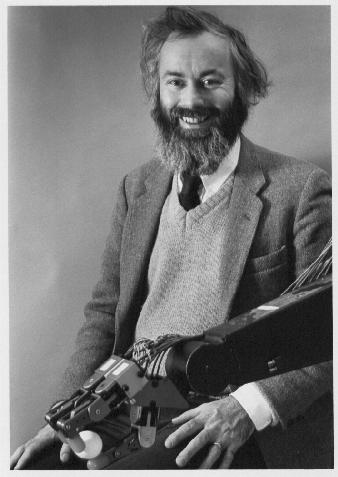|

Robin John Popplestone, one of the early pioneers in Robotics and Computer Programming Languages, died on 14th April 2004 in Glasgow, Scotland, after a 10-year battle with prostate cancer. He was 65.
Robin was born in Bristol in 1938. After the war his family moved to Belfast, where he grew up. He was educated at Queen's University Belfast, receiving an honours degree in mathematics in 1960. He first worked with computing while studying for a PhD initially at Manchester University and then at Leeds University. His project was to program a computer to prove logic theorems. In this he succeeded, but his creativity got the upper hand over the tedium of writing up the thesis, so he neglected the thesis and instead used the University computer to design a boat, a very early example of computer aided design. He built the boat and set sail for the University of Edinburgh, where he had been offered a Research Fellowship. In the North Sea, a storm arose; Robin was taken aboard a passing ship but the boat, alas, went to the bottom (it is a myth, however, that the boat contained a draft of his PhD thesis). Sailing remained a passionate pursuit nonetheless, and though Computer Science became his profession, mathematics remained at the heart of his research.
When Robin arrived in Edinburgh in 1965 there was only a small “Computer Unit” and an “Experimental Programming Unit”, of which he became the fourth staff member. The University did not yet own a computer. The Experimental Programming Unit was led by Donald Michie, who had worked with Turing during WWII, building a tape driven computing device to crack the German Enigma cipher. The Unit was the beginning of work on Artificial Intelligence at Edinburgh.
Soon after Robin’s arrival the Unit acquired an Elliott computer, large but puny by today’s standards: about one twelfth of a megabyte of random access memory. On this Robin designed and implemented a programming language, “POP-2,” for non-numerical work, together with its operating system (http://www-robotics.cs.umass.edu/~pop/pop_development.html). POP-2 was extremely expressive and used minimal computing resources: an angel dancing on a pin. Although POP-2 never achieved international currency it was used elsewhere in the UK and gave a head start to Artificial Intelligence work at Edinburgh. It formed the basis for the UK’s second time-shared computer operating system, after Cambridge, enabling several users to share one (very expensive) computer from keyboards instead of queuing up with rolls of punched tape. It was created by colleagues at the Unit, with Robin’s help. Boyer and Moore at Edinburgh used POP-2 to develop a logic proof system whose latest incarnation is today being used to check the arithmetic hardware for the Athlon computer processors, Intel’s main rival.
In 1972, Robin was a member of a small team at Edinburgh, which developed a hand-eye robotic device that could assemble some simple models, a toy boat and car, from a few pieces. The previous best was a computer at MIT, which managed to build a pile of bricks. The system was trained to recognise the pieces visually, then they were dumped on the table, the system separated them and the hand put them together to make the model. The program to control the hand motion was written by Robin. The system could be made to build a different model after a day’s work training and reprogramming it. All this was based on Robin’s work on POP-2, without which it would never have happened. Robin continued to do visionary work in Robotics involving the integration of multi-modal sensing (including vision) into robotic control and the development of techniques for modelling of and spatial reasoning about geometric objects. He established and led one of the first world-class Robotics research groups in Europe.
In 1985, Robin joined the faculty of the University of Massachusetts Amherst as a Professor of Computer Science and Director of the Laboratory for Perceptual Robotics. With his students there, he advanced group theoretic frameworks for describing relationships between bodies and describing symmetries in tasks that could be exploited by control and planning. In 1990, he was selected as a Founding Fellow of the American Association for Artificial Intelligence (AAAI) in recognition of his seminal contributions to AI. Due to illness, he retired in 2001 from the University of Massachusetts as an Emeritus Professor, returning to Glasgow, Scotland to be near his family and the sea.
Some would describe Robin as the classic absent-minded professor in appearance, and few who knew him could help but notice that he was truly unique, sometimes a touch eccentric, with flashes of genius. He was a quirky, modest and very likeable person, a creative software designer and skilled and elegant implementer at a time when one person could make a major contribution to exploring the potential of computing.
He was a beloved advisor to many students, a warm and caring friend, a deep intellectual thinker on a wide range of subjects, a witty conversationalist and an expert sailor. After retiring, he pursued his interest in the Irish language by beginning work on a translation program. He spent considerable time in his later years living with his wife on their boat, sailing extensively around Scotland, Ireland, Sweden, and Denmark.
Robin was a profoundly unique person who touched the lives of all who knew him. He leaves his wife, Professor Kristin Morrison, and three children by earlier marriages: Michael Popplestone, Jennifer Dukovich, and Sally Brackenridge, as well as three grandchildren. He is also survived by his mother and three brothers.
|
Informatics Forum, 10 Crichton Street, Edinburgh, EH8 9AB, Scotland, UK
Tel: +44 131 651 5661, Fax: +44 131 651 1426, E-mail: school-office@inf.ed.ac.uk Please contact our webadmin with any comments or corrections. Logging and Cookies Unless explicitly stated otherwise, all material is copyright © The University of Edinburgh |